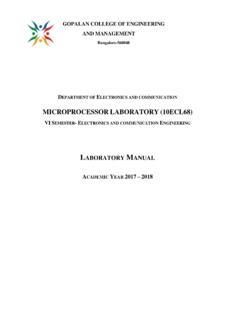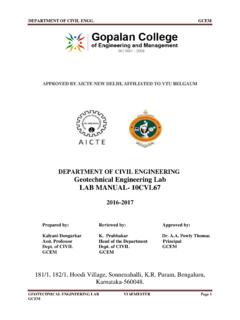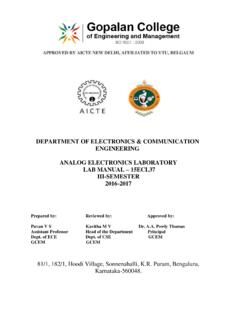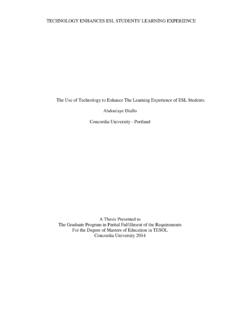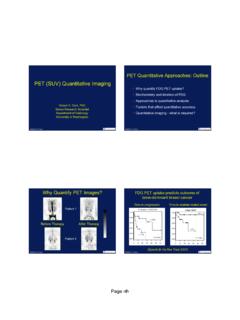Transcription of DEPARTMENT OF ELECTRONICS & COMMUNICATION …
1 APPROVED BY AICTE NE DEPARTMENT OF DIGITAL SIGNAL PROCESSING Prepared by: Srilakshmi B Dept. of ECE GCEM 81/1, 182/1, Hoodi Village, Sonnenahalli, Puram APPROVED BY AICTE NEW DELHI, AFFILIATED TO VTU BELGAUM DEPARTMENT OF ELECTRONICS & COMMUNICATIONENGINEERING DIGITAL SIGNAL PROCESSING LAB (10 ECL57)Vth Sem- ECE 2016-2017 Reviewed by: Approved Kavitha M V Dr. Powly ThomasHead of the DEPARTMENT Principal Dept. of ECE GCEM GCEM 81/1, 182/1, Hoodi Village, Sonnenahalli, PuramKarnataka-560048. TO VTU BELGAUM ELECTRONICS & COMMUNICATION (10 ECL57) Approved by: Dr.
2 Powly Thomas 81/1, 182/1, Hoodi Village, Sonnenahalli, Puram, Bengaluru, INDEX Syllabus i Course objectives, Course outcome ii Do s & Don ts iii List of Experiments iv SYLLABUS DIGITAL SIGNAL PROCESSING LABORATORY Subject Code : 10 ECL57 IA Marks : 25 No. of Practical Hrs/Week: 03 Exam Hours : 03 Total no. of Practical Hrs. : 42 Exam Marks : 50 A LIST OF EXPERIMENTS USING MATLAB 1. Verification of Sampling theorem.
3 2. Impulse response of a given system 3. Linear convolution of two given sequences. 4. Circular convolution of two given sequences 5. Autocorrelation of a given sequence and verification of its properties. Cross correlation of given sequences and verification of its properties. 6. Solving a given difference equation. 7. Computation of N point DFT of a given sequence and to plot magnitude and phase spectrum. 8. Linear convolution of two sequences using DFT and IDFT. 9. Circular convolution of two given sequences using DFT and IDFT 10. Design and implementation of FIR filter to meet given specifications. 11. Design and implementation of IIR filter to meet given specifications. LIST OF EXPERIMENTS USING DSP PROCESSOR 1.
4 Linear convolution of two given sequences. 2. Circular convolution of two given sequences. 3. Computation of N- Point DFT of a given sequence 4. Realization of an FIR filter (any type) to meet given specifications .The input can be a signal from function generator / speech signal. 5. Audio applications such as to plot time and frequency (Spectrum) display of Microphone output plus a cosine using DSP. Read a wav file and match with their respective spectrograms 6. Noise: Add noise above 3kHz and then remove; Interference suppression using 400 Hz tone. 7. Impulse response of first order and second order system i Objectives: Analyze and implement digital signal processing systems in time domain.
5 Design frequency-selective digital filters. Design digital filters using windows. Sample and reconstruct analog signals. Compute circular convolution,linear convolution and the discrete Fourier transform (DFT) of discrete-time signals. Analyze and implement digital systems using the DFT and the fast Fourier Transform (FFT). Use MATLAB for DSP system analysis and design. Outcomes: The student will be able to carry out simulation of DSP systems. The student will be able to demonstrate their abilities towards DSP processor based implementation of DSP systems. The student will be able to analyze Finite word length effect on DSP systems. The student will be able to demonstrate the applications of FFT to DSP.
6 The student will be able to implement adaptive filters for various applications of DSP. ii Do s and Dont s: Do not handle any equipment without reading the instructions /Instruction manuals. Observe type of sockets of equipment power to avoid mechanical damage. Do not insert connectors forcefully in the Sockets. Strictly observe the instructions given by the Teacher/ Lab Instructor. It is mandatory to come to lab in a formal dress (Shirts, Trousers, ID card, and Shoes for boys). Strictly no Jeans for both Girls and Boys. It is mandatory to come with observation book and lab record in which previous experiment should be written in Record and the present lab s experiment in Observation book.
7 Observation book of the present lab experiment should be get corrected on the same day and Record should be corrected on the next scheduled lab session. Mobile Phones should be Switched OFF in the lab session. Students have to come to lab in-time. Late comers are not allowed to enter the lab. Prepare for the viva questions. At the end of the experiment, the lab faculty will ask the viva Questions and marks are allotted accordingly. Bring all the required stationery like graph sheets, pencil & eraser, different color pens etc. for the lab class. iii List of Experiments Sl. No. EXPERIMENT Page No. 1. Verification of Sampling theorem. 13 2. Impulse response of a given system 21 3.
8 Linear convolution of two given sequences. 29 4. Circular convolution of two given sequences 37 5. Autocorrelation of a given sequence and verification of its 42 6. Cross correlation of given sequences and verification of its properties 48 7. Solving a given difference equation. 56 8. Computation of N point DFT of a given sequence and to plot magnitude and phase spectrum 65 9. Linear convolution of two sequences using DFT and IDFT. 74 10. Circular convolution of two given sequences using DFTand IDFT 80 11. implementation of FIR filter to meet given specifications. 85 12. Design and implementation of IIR filter to meet given specifications. 91 LIST OF EXPERIMENTS USING DSP PROCESSOR 1 Linear convolution of two given sequences.
9 107 2 Circular convolution of two given sequences. 110 3 Computation of N- Point DFT of a given sequence 113 4 Impulse response of first order and second order system 116 5 Realization of an FIR filter (any type) to meet given specifications . 119 6 Noise: Add noise above 3kHz and then remove; Interference suppression using 400 Hz tone. 125 iv DIGITAL SIGNAL PROCESSING LAB [10 ECL57] DSP USING MATLAB MATLAB:MATLAB is a software package for high performance numerical computation and visualization provides an interactive environment with hundreds of built in functions for technical computation, graphics and animation. The MATLAB name stands for MATrix Laboratory The diagram shows the main features and capabilities of MATLAB.
10 MATLAB GRAPHICS COMPUTATIONS EXTERNAL INTERFACE 2-D Graphics Linear Algebra Interface with C and 3 D Graphics Signal Processing FORTAN language Animations Polynomial and interpolation Quadrature solution of ODE S TOOL BOX Signal Processing Image Processing Statistics Control Systems Neural Network Communications At its core ,MATLAB is essentially a set (a toolbox ) of routines (called m files or mex files ) that sit on your computer and a window that allows you to create new variables with names ( voltage and time) and process those variables with any of those routines ( plot voltage against time, find the largest voltage, etc).
